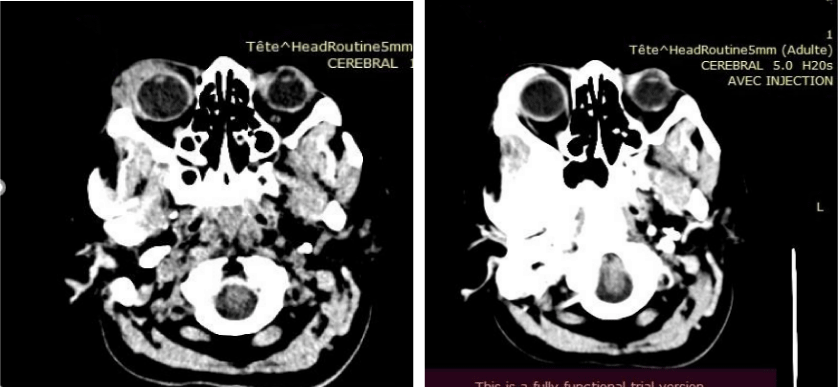
Case Report
Austin J Radiol. 2022; 9(4): 1202.
Eyelid Swelling: Rare Metastasis from Breast Cancer
Berrada K*, Ouali IO, Jiddane M and Touarsa F
Department of Radiology, Specialities Hospital, Ibn Sina, Rabat, Morocco
*Corresponding author: Kenza Berrada, Department of Radiology, Resident Radiology, Specialities Hospital, Ibn Sina, Rabat, Morocco
Received: July 26, 2022; Accepted: August 19, 2022; Published: August 26, 2022
Abstract
Breast cancer is the first cancer associated with skin metastases in women. Eyelid metastases are a very rare variety, difficult to diagnose with often poor prognosis. The authors report a rare case of a 54-year-old patient followed for an early metastatic breast cancer, who has presented for 7 months with swelling of the upper eyelid of the right eye. These palpebral metastases occur first as part of a polymetastasis of breast cancer or bladder cancer. Diagnosis is difficult, imaging plays a key role in guiding diagnosis
Keywords: Eyelid Swelling; Breast Cancer; Metastasis
Introduction
Palpebral metastasis are rare, breast cancer is the first cause. Diagnosis is difficult, and can be mistakenly taken for benign pathology. Imaging plays a fundamental role in guiding diagnosis. But, biopsy remains the faithful way to correct the diagnosis. We report the case of a patient with a voluminous palpebral swelling, evolving for 7 months, in a context of polymetastaic breast cancer.
Medical Observation
Our patient is a 54-year-old patient, followed for metastatic breast cancer in the sacrum, who has had for 7 months a right palpebral swelling, initially treated as palpebral infiltration but not improved after medical treatment. (Figure A and A’) Initially, a palpebral ultrasound was performed by a superficial probe of 7 MHZ. It objectified the presence of an upper palpebral mass, heterogeneous hyperechoic echostructure containing pure anechogenic fluid zones, poorly limited contours and very vascularized to color Doppler (Figure B, C and D). An orbital scan complement, without and with injection of contrast medium, showed a palpebral mass of spontaneous tissue density strongly enhanced after injection of contrast medium, irregular contours coming into contact with the lateral right muscle without any signs of invasion (Figure E, F).

Figure 1: Images (a and a’) of the swelling of the superolateral part of the
eyelid of the right eye caused by ptosis.

Figure 2: Ultrasound sections (longitudinal: b and c, axial: a) showing the upper palpebral mass, heterogeneous hyperechoic echostructure containing anechoic
fluid areas, poorly limited spiculated contours.

Figure 3: Axial scan sections without (e) and after (f) injection of the contrast medium, showing the right palpebral mass of tissue density that increased sharply
after injection of the contrast medium.
Discussion
Palpebral metastases are rare. Aurora and Blodi identified 3 cases of metastatic cancer out of 214 malignant palpebral lesions. Palpebral metastases usually develop in a polymetastatic setting of breast or lung cancer. The diagnosis [1,2] is not obvious when they are inaugural or when thenotion of a history of cancer is ignored. They appear as a palpebral infiltration or a subcutaneous mobile nodule [3].
In our case, the patient consulted for a simple isolated palpebral swelling, responsible for homolateral ptosis (a and a’). She was lost to follow-up for 7 months, with no clinical improvement after symptomatic treatment.
Imaging plays a fundamental role in guiding diagnosis. There is no typical look in metastasis imaging. Generally, metastases resemble the primary tumor. The purpose of imaging is to guide the diagnosis, and especially to establish the reports of the tumors in order to define the therapeutic possibilities for the clinician. Palpebral ultrasound remains the first-line examination. Complements in cutting imaging, without and with injection of contrast remain essential to establish the diagnosis. In our case, the ultrasound showed an upper palpebral mass, heterogeneous hyperechoic echostructure containing anechoic fluid areas, poorly limited contours and very vascularized to the Doppler (Figure B, C and D). The orbital scan complement, without and with injection of contrast medium, showed a palpebral mass of spontaneous tissue density strongly enhanced after injection of contrast medium, irregular contours coming into contact with the lateral right muscle without any signs of invasion (Figure E, F). The biopsy helps to correct the diagnosis. Histology more or less reproduces the architecture and cytology of primary cancer. According to the literature, primary cancer is most often a ductal adenocarcinoma type breast cancer. In our case, the pathological study showed that it is a ductal adenocarcinoma.
Conclusion
Faced with a palpebral swelling evolving in a context of neoplasia, we must always think of a metastatic origin. Imaging plays a fundamental role in guiding diagnosis.
References
- Aurora AL, Blodi FC. Lesions of the eyelids: A clinicopathologic study. Surv Ophthalmol. 1970; 15: 94-104.
- Conjunctivo-palpebral metastasis of bladder cancer H. Offret (1), J. Porras (2), O. Offret (1), M. Labetoulle (1), M. Fabre (2).
- Conjunctivo-palpebral metastasis of bladder cancer H. Offret (1), J. Porras (2), O. Offret (1), M. Labetoulle (1), M. Fabre (2).